View in other NatureServe Network Field Guides
NatureServe
Montana
Utah
Wyoming
Idaho
Wisconsin
British Columbia
South Carolina
Yukon
California
New York
Poverty Oatgrass - Danthonia spicata
Native Species
Global Rank:
G5
State Rank:
S4
(see State Rank Reason below)
C-value:
Agency Status
USFWS:
USFS:
BLM:
External Links
State Rank Reason (see State Rank above)
Danthonia spicata has been found in portions of western, central, and southeastern Montana. It has been found in a wide variety of habitats and disturbance regimes, including dry slopes at the edge of forests, moist rock outcrops, forests dominated by ponderosa pine, Douglas-fir, lodgepole, and western red cedar, gulches, roadsides, timber harvests, burned areas, and dry, rocky habitats. Although existing data suggests it is secure, current data that specifically indicates population sizes, distribution, and threats are needed.
- Details on Status Ranking and Review
Range Extent
ScoreG - 200,000-2,500,000 sq km (~80,000-1,000,000 sq mi)
Area of Occupancy
ScoreE - 26-125 4-km2 grid cells
Number of Populations
ScoreC - 21 - 80
Environmental Specificity
ScoreD - Broad. Generalist or community with all key requirements common
Threats
ScoreD - Low
CommentNo known threats.
General Description
PLANTS: Perennial grass that grows from 30–60 cm (Lesica et al. 2012).
LEAVES: Blades are 1–3 mm wide; sheaths are essentially hairless to hairy with a collar that is usually hairy; ligule 0.5–1 mm long (Lesica et al. 2012).
INFLORESCENCE: A contracted panicle or raceme of 3–5 cm length, with 5 to 10 spikelets (Lesica et al. 2012). Spikelets 10–15 mm long with 4 to 7 florets. Lemmas tightly enfolded by glumes, 3–5 mm long, sparsely but uniformly hairy on back except at the tip, with awns 5–8 mm long (Lesica et al. 2012).
Species Range
Montana Range
Range Descriptions
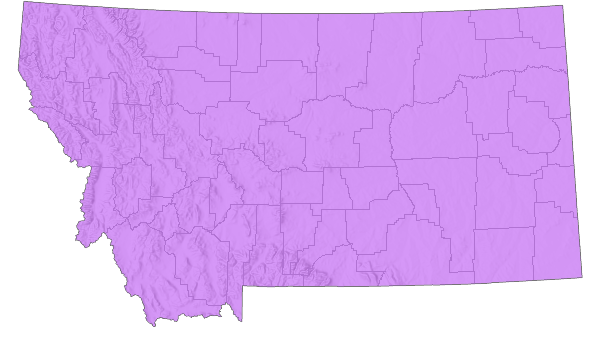
 Native
Native
Range Comments
Through most of boreal and temperate North America, extending south into northeastern Mexico (FNA 2003).
Observations in Montana Natural Heritage Program Database
Number of Observations: 147
(Click on the following maps and charts to see full sized version)
Map Help and Descriptions
Relative Density
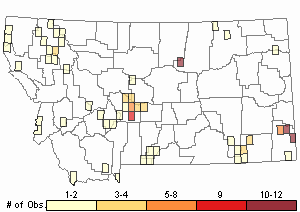
Recency
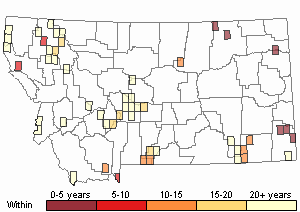
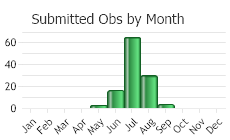
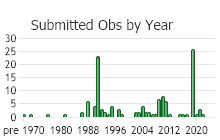
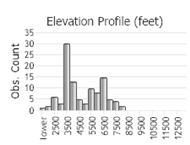 (Observations spanning multiple months or years are excluded from time charts)
(Observations spanning multiple months or years are excluded from time charts)
Habitat
Dry mountain meadows (Lesica et al. 2012). Dry rocky, sandy, or mineral soils, and generally in open, sunny areas (FNA 2003).
Ecology
The morphology of Danthonia spicata is variable because of its slow clonal growth, extensive cleistogamy, and limited dispersal (FNA 2003). This has resulted in morphologically uniform populations which are sometimes given varietal names. Microsites can also affect its morphology. Plants growing in shady or moist habitat can lack the distinctive curled or twisted blades that are found in individuals growing in open habitats (FNA 2003). Plants growing in shaded or moist habitats also tend to have smaller spikelets and pilose foliage (FNA 2003).
Stewardship Responsibility
References
- Literature Cited AboveLegend:
 View Online Publication
View Online Publication Flora of North America Editorial Committee. 2003. Flora of North America North of Mexico. Vol. 25. Magnoliophyta: Commelinidae (in part): Poaceae, part 2. Oxford Univ. Press, New York. xxv + 781 pp.
Flora of North America Editorial Committee. 2003. Flora of North America North of Mexico. Vol. 25. Magnoliophyta: Commelinidae (in part): Poaceae, part 2. Oxford Univ. Press, New York. xxv + 781 pp. Lesica, P., M.T. Lavin, and P.F. Stickney. 2012. Manual of Montana Vascular Plants. Fort Worth, TX: BRIT Press. viii + 771 p.
Lesica, P., M.T. Lavin, and P.F. Stickney. 2012. Manual of Montana Vascular Plants. Fort Worth, TX: BRIT Press. viii + 771 p.
- Additional ReferencesLegend:
 View Online Publication
View Online Publication
Do you know of a citation we're missing? Ament, R.J. 1995. Pioneer Plant Communities Five Years After the 1988 Yellowstone Fires. M.Sc. Thesis. Bozeman, MT: Montana State University. 216 p.
Ament, R.J. 1995. Pioneer Plant Communities Five Years After the 1988 Yellowstone Fires. M.Sc. Thesis. Bozeman, MT: Montana State University. 216 p. Lesica, P., M.T. Lavin, and P.F. Stickney. 2022. Manual of Montana Vascular Plants, Second Edition. Fort Worth, TX: BRIT Press. viii + 779 p.
Lesica, P., M.T. Lavin, and P.F. Stickney. 2022. Manual of Montana Vascular Plants, Second Edition. Fort Worth, TX: BRIT Press. viii + 779 p.
- Web Search Engines for Articles on "Poverty Oatgrass"





